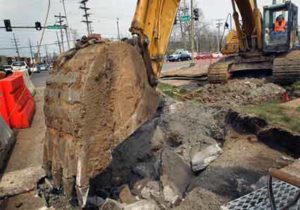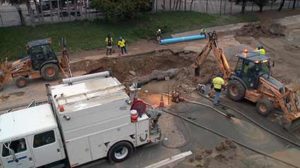Pipeline Ruptures in Missouri
Collapsing Pipelines and Hidden Cracks: The Hidden Costs of Aging Infrastructure
In Maplewood, Missouri, a major traffic disruption unfolded when a ruptured pipeline caused a sizeable sinkhole at a busy intersection. This incident isn’t unique; just last month, San Diego dealt with a similar problem after a break in an aging cast-iron water pipeline led to road closures, water damage to nearby homes, and yet another sizable sinkhole. These events paint a troubling picture: America’s outdated infrastructure is under constant strain, resulting in frequent water main breaks. The issue worsens as pipelines installed decades ago continue to deteriorate due to corrosion and wear. Addressing this problem isn’t easy—repairing or replacing these systems requires significant financial investment, which many municipalities struggle to afford. According to the American Society of Civil Engineers (ASCE), America’s infrastructure received a D+ rating in their 2013 report card, highlighting the growing gap between necessary funding and available resources. For instance, Missouri faces a staggering $7.1 billion bill for drinking water infrastructure upgrades and an additional $5.8 billion for wastewater infrastructure. Nationally, about 240,000 water main breaks occur annually, with estimates suggesting it will cost over $1 trillion to replace them all in the coming decades. The Maplewood pipeline, described by Allen Muehlher from the Metropolitan St. Louis Sewer District (MSD), was a 42-inch corrugated metal pipe laid in the 1930s. Years of exposure to corrosive elements eventually led to its collapse. To prevent further incidents, Missouri American Water Company has taken proactive steps, especially during seasons when ruptures are most likely. Over the past five years, they’ve replaced 141 miles of old water mains in St. Louis County and parts of St. Charles County, investing around $138.5 million in the process. However, replacing entire pipelines isn’t always the best—or cheapest—solution. Alternatives like HJ3’s carbon fiber repair systems can cut costs by up to 80% compared to traditional replacements. These methods use less material and labor while effectively restoring damaged pipes, bridges, and other underground structures. Emergency repairs often incur even higher costs due to road closures, property damage, debris removal, and full-scale replacements. Efficiency and affordability are key to addressing these challenges. Effective maintenance strategies play a critical role in managing these issues. As MSD spokesperson Lance LeComb notes, ongoing failures like those in Maplewood and San Diego underscore the urgent need for proactive measures to avoid future crises. â€

Aluminum Foil Liner Paper Bags
Customize your logo paper bag,Eco-friendly paper bag for kebabs,Pizza paper bag,A paper bag of fried burgers
Qingzhou Xincheng Packaging Co., LTD , https://www.qzxcbc.com